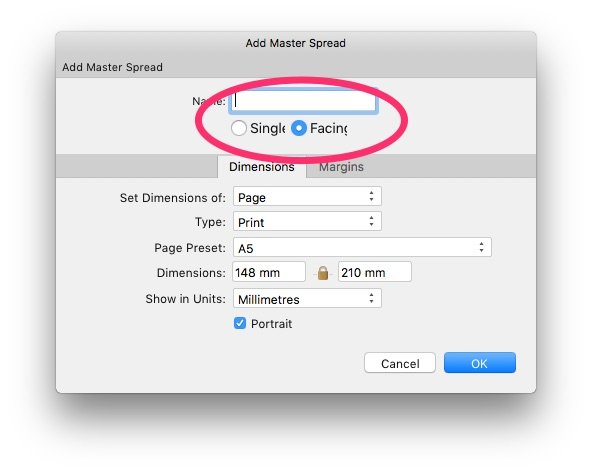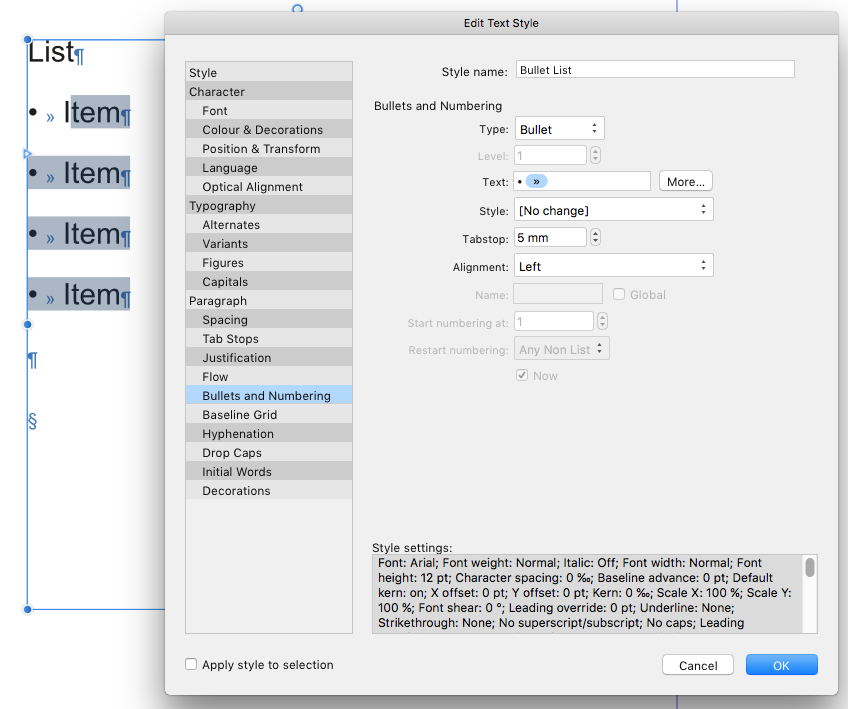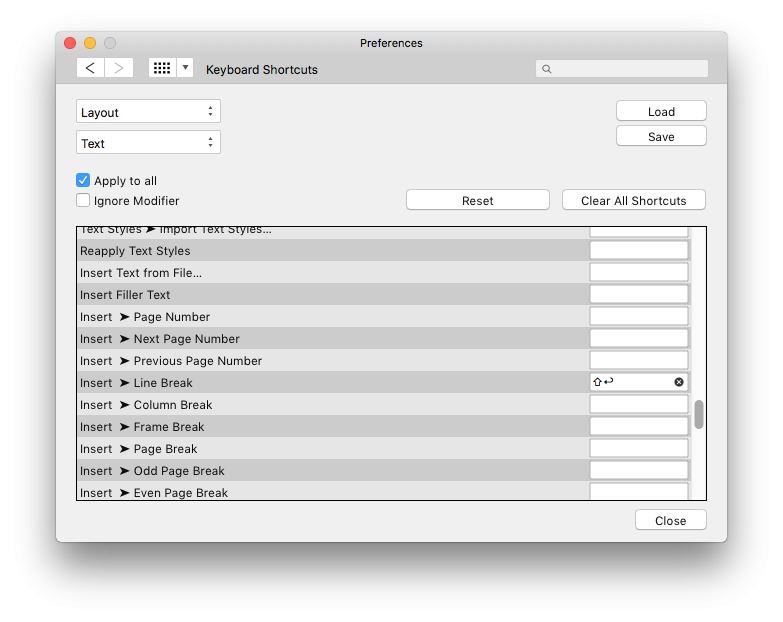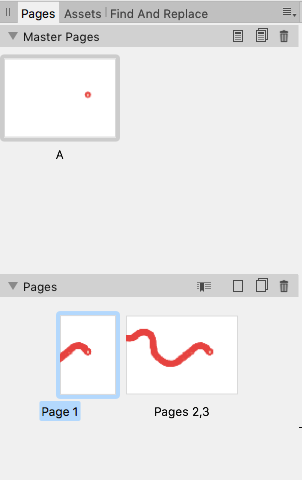
Jim_A
Members-
Posts
73 -
Joined
-
Last visited
Everything posted by Jim_A
-
Initial Words Sticking with first Font applied
Jim_A replied to ffca's topic in [ARCHIVE] Publisher beta on macOS threads
I agree with you. You've misunderstood my post. I'm advocating that only paragraph styles should display all values. Character styles should show all blank fields except for the values you set. In the example you gave, the character style should show all blank fields except for the red text fill. [No change] is ambiguous, for reasons I described in an earlier post in this thread. -
Initial Words Sticking with first Font applied
Jim_A replied to ffca's topic in [ARCHIVE] Publisher beta on macOS threads
All this confusion will go away if AfPub displayed the currently set values for the paragraph style instead of 'No change'. (Keep character style values blank by default. Show only overrides, for reasons stated in the posts above.) Many (perhaps most) paragraph styles will be based on another paragraph style. So, when you go to edit one of those styles, which would you rather see... -
Initial Words Sticking with first Font applied
Jim_A replied to ffca's topic in [ARCHIVE] Publisher beta on macOS threads
Again, the problem described in the orginal post was caused by 'No Change' meaning 'No change from the default paragraph style' instead of 'No change from the NEW paragraph style'. 'No Change' is therefore ambiguous, and depends on whether you clicked the 'Reset formatting' button when setting up the style. And there's no easy way to determine that. A blank field says, 'Nothing will be changed or set.' -
Initial Words Sticking with first Font applied
Jim_A replied to ffca's topic in [ARCHIVE] Publisher beta on macOS threads
Yes, this is the value of blank fields. The blank field for font size means, 'Leave the font size at whatever the paragraph style has set.' If the field said '8pt', it would mean, 'Whatever the paragraph style has set for font size, make it 8pt.' -
Initial Words Sticking with first Font applied
Jim_A replied to ffca's topic in [ARCHIVE] Publisher beta on macOS threads
InDesign has a [Basic Paragraph] style with default settings. The default character style is [None], which means 'don't make any changes to the paragraph style', which is implied by the blank fields. If the character style dialogue showed all the text attribute values, how would you know which were overrides to the paragraph style? If instead of blank fields it said 'No Change', how would you know if a default character styling was being applied (which is what AfP does at the moment, at least regarding the main font selection, unless you click the 'Reset formatting' button.) -
Initial Words Sticking with first Font applied
Jim_A replied to ffca's topic in [ARCHIVE] Publisher beta on macOS threads
If text is selected which has paragraph style overrides, I agree. If no text is selected, it should default to no styling. And ideally, all the character style formatting fields should be blank, not 'No change'. (No change from what? The default styling? The applied paragraph style?) -
Initial Words Sticking with first Font applied
Jim_A replied to ffca's topic in [ARCHIVE] Publisher beta on macOS threads
I think the problem described in the initial post (by ffca) underlines a basic fault in the way character styles are implemented in Publisher. A new character style should have no styling at all by default. Any changes made within the character style should override the paragraph style, but otherwise inherit everything from the paragraph style. By default, a new character style in AfP has the default font applied to it (in my case, Arial). This overrides the font applied in the paragraph style, leading to the problems described in the intial post above. I've found by trial and error that clicking the 'Reset formatting' button in the character style editor gets around this problem. But a new character style should be reset by default (i.e. no styling applied), otherwise it will lead to all kinds of confusion. -
The first time I tried to reproduce this (also in a 'Print' document) the colour wheel in the dialogue box had a strange interference pattern which moved as the sliders were adjusted. However, I can't reproduce this. I do notice (possibly unrelated) that the selected object is no longer selected after applying Adjustments or Masks from the layer panel. (Applying Layer Effects keeps the object selected.) [macos AfPub beta 1.7.0.145]
-
+1 for Aloof. 'No change' is useful for character styles, where text attributes are shared with the paragraph style. However, with a paragraph style based on another paragraph style it's helpful to see the values. Otherwise you're working in the dark. For instance, set up a Body style for the main text, then create a Body First Para style (based on Body style) which has Drop Caps and Initial Words enabled. When you edit the Body First Para style, the values for the Drop Caps and Initial Words show as 'No change', even though they weren't enabled in the original Body style. You can get some information from the Style settings box at the bottom of the editor window, but some values (such as Initial Words Max word count) don't show. Best to keep 'No change' for character styles, as there it helps to identify which attributes have been overridden.
-
In the Add Master Page dialogue box the text under the Name field is truncated. Edit: I have the Font UI Size set to Large in Preferences.
-
Apply Styles – Options behave strangely
Jim_A replied to A_B_C's topic in [ARCHIVE] Publisher beta on macOS threads
I agree with Wosven: being able to apply paragraph styles to individual characters is confusing. Paragraph styles for paragraphs. (Whole paragraphs.) Character styles for characters. It is confusing to be able to apply more than one paragraph style to a paragraph, especially as the order in which they are applied determines which elements of the style appear. For instance, try setting a paragraph to Body style, select all, then 'Apply "Line Below" to Characters'. Now try it in reverse. If Body style is applied first, there is no line below. If Line Below style is applied first, the line below appears. And with multiple paragraph styles applied, there is no quick way to clear overrides (or even find where they are). Selecting the whole paragraph then clicking on another style sometimes leaves one of the original paragraph styles selected. Also, there is a bug (?) where if a new text box is drawn with a style already selected, changing the style adds the style to the original one instead of replacing it. The only way out of this is to select 'Detach Characters from "Stylename"' from the flyout menu. (But, these bugs are inconsistent and depend on which styles have been applied before.) I realise there are still bugs to remove, so it's hard to work out for sure how styles will eventually work, but I think being able to apply multiple paragraph styles is a mistake. The whole idea of one style being 'based on' another is surely a better way (and already implemented), and then keep character and paragraph styles separate. -
Apply a mask to an object using the icon at the bottom of the Layers panel, then right-click the mask in the Layers panel and select Edit Mask, causes crash. [Mac beta 1.7.0.128]
-
Bleed and margin border colors
Jim_A replied to Bo Lovenhjelm's topic in Feedback for Affinity Publisher V1 on Desktop
+1 for different colours for guides, bleeds, margins, layers, text boxes, etc. -
- Find / Replace is broken at the moment (can't paste some invisible characters; can't replace with nothing; magnifying glass under Find is missing in Mac version, etc). I'm going to wait for a later beta release before I use it. - I think I had to manually add the soft return shortcut as shift-return by going to Preferences > Keyboard Shortcuts > Text (popup) > Insert > Line Break. (see screenshot) - Bulleted lists are best set up as a style. Create a new style, then select the Bullets and Numbering tab. The distance between the bullet and text can be altered using the Tabstop value. (see screenshot)
-
Changes to the margins of master pages don’t apply to the document pages. Even clearing then reapplying a master to a document page doesn’t update any margin changes. Also, new pages created with a master applied don’t have the same margins as the master (unless they're the default margin settings).
-
Graphic Elements causes crash
Jim_A replied to solaris's topic in [ARCHIVE] Publisher beta on macOS threads
+1. Also, getting frequent crashes when adjusting the sliders for the various shape tools. In addition, the sliders remain floating onscreen, as has been reported in other threads. I do have crash logs, but I'm not sure if or where to post them, or which parts are relevant. Crash log ========= Application Specific Information: objc_msgSend() selector name: performSelector:withObject: Performing @selector(onSliderChanged:) from sender Slider 0x7fcbb9a10750 -
Story editor - mandatory
Jim_A replied to Jowday's topic in Feedback for Affinity Publisher V1 on Desktop
+1 for Story Editor. It’s an extremely useful tool, especially, as Hank said, for working with overset text, identifying styles and invisible characters. The alternative is to link overset text to a temporary box on the pasteboard. This is cumbersome and impractical with longer documents. And it doesn’t provide a way to identify which styles have been applied. The story editor has also saved me much time and frustration in trying to track down rogue column break or page break characters in the middle of some imported text.







